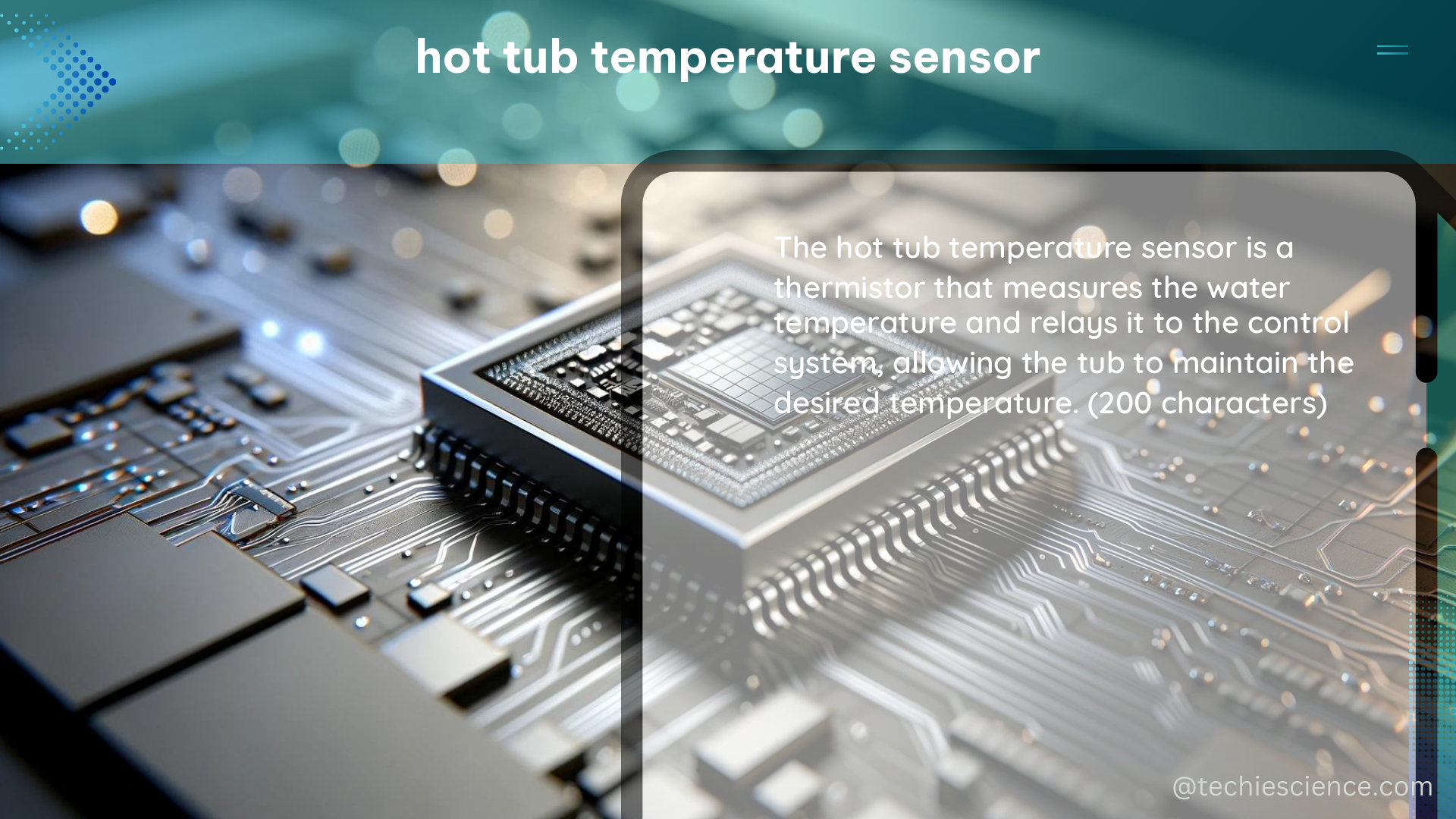Hot tub temperature sensors are essential components that play a crucial role in maintaining the safety and comfort of hot tub users. These sensors are responsible for monitoring the water temperature and ensuring it remains within the recommended range, typically between 99°F and 104°F (37°C and 40°C). Exceeding this range can lead to serious health issues, such as heat exhaustion and heat stroke, making the proper functioning of these sensors a top priority.
Understanding the Technical Specifications of Hot Tub Temperature Sensors
Hot tub temperature sensors are typically made of temperature-sensitive materials, such as thermistors or resistance temperature detectors (RTDs), which change their resistance in response to temperature variations. This change in resistance is then converted into a temperature reading by the hot tub’s control system.
Thermistor-based Temperature Sensors
Thermistors are the most common type of temperature sensor used in hot tubs. These devices are made of semiconductor materials that exhibit a significant change in resistance with temperature. Thermistors can be classified into two main types:
-
Negative Temperature Coefficient (NTC) Thermistors: These thermistors have a resistance that decreases as the temperature increases. NTC thermistors are widely used in hot tub temperature sensors due to their high sensitivity and fast response time.
-
Positive Temperature Coefficient (PTC) Thermistors: These thermistors have a resistance that increases as the temperature increases. PTC thermistors are less common in hot tub applications but can be used in certain specialized applications.
The resistance-temperature relationship of thermistors is typically non-linear, and manufacturers provide calibration curves or equations to convert the resistance measurements into accurate temperature readings.
Resistance Temperature Detector (RTD) Sensors
RTD sensors are another type of temperature sensor used in hot tubs. These sensors are made of metals, such as platinum, copper, or nickel, and their resistance increases linearly with temperature. RTD sensors are known for their high accuracy, stability, and repeatability, making them a reliable choice for hot tub temperature monitoring.
The resistance-temperature relationship of RTD sensors is typically linear, and the sensor’s resistance at a specific temperature can be calculated using the following formula:
R = R0 * (1 + α * (T - T0))
Where:
– R is the resistance at the measured temperature T
– R0 is the resistance at the reference temperature T0
– α is the temperature coefficient of resistance for the specific metal used in the RTD
Accuracy and Precision Requirements
Hot tub temperature sensors must meet strict accuracy and precision requirements to ensure user safety and comfort. The industry standard for hot tub temperature sensor accuracy is typically within ±2°F (±1°C) of the actual water temperature. This level of accuracy is essential to prevent users from being exposed to water temperatures that are too hot or too cold, which can lead to health issues.
In addition to accuracy, hot tub temperature sensors must also be able to withstand the harsh environmental conditions of a hot tub, including high temperatures, humidity, and chemical exposure. Manufacturers often design their sensors with specialized materials and enclosures to protect them from these challenging conditions and ensure long-term reliability.
Maintaining Hot Tub Temperature Sensors

Proper maintenance of hot tub temperature sensors is crucial to ensure their continued accurate performance and the overall safety of the hot tub. Here are the key steps to maintain hot tub temperature sensors:
Regular Inspection and Cleaning
-
Visual Inspection: Regularly inspect the temperature sensor for any signs of damage, such as cracks, corrosion, or physical wear. If the sensor appears damaged, it should be replaced immediately.
-
Cleaning: Use a soft cloth and warm, soapy water to gently clean the temperature sensor and remove any buildup of debris or mineral deposits. Avoid using abrasive cleaners or tools, as they can damage the sensor.
Accuracy Testing
-
Comparison to a Trusted Thermometer: Periodically test the accuracy of the hot tub temperature sensor by comparing its readings to those of a separate, calibrated thermometer. This will help identify any drift or inaccuracies in the sensor’s measurements.
-
Calibration: If the temperature sensor is found to be outside the acceptable accuracy range, it may need to be recalibrated or replaced. Refer to the manufacturer’s instructions for the proper calibration procedure.
Sensor Replacement
If the hot tub temperature sensor is damaged or cannot be accurately calibrated, it should be replaced. When replacing the sensor, be sure to use a compatible model that meets the same technical specifications as the original. Consult the hot tub manufacturer or a qualified technician for guidance on the appropriate replacement sensor.
Conclusion
Hot tub temperature sensors are critical components that ensure the safety and comfort of hot tub users. By understanding the technical specifications of these sensors, including their construction, accuracy requirements, and maintenance needs, hot tub owners can take proactive steps to maintain their hot tub’s temperature monitoring system and enjoy a safe and enjoyable hot tub experience.
References:
- 2023 Annex to the Model Aquatic Health Code, https://www.cdc.gov/mahc/pdf/2023-mahc-annex-508.pdf
- Science Extended Standards – OCALI, https://www.ocali.org/up_doc/ScienceExtendedStandards.pdf
- Maintenance Performance Measurement and Management, http://ltu.diva-portal.org/smash/get/diva2:994674/FULLTEXT01.pdf

The lambdageeks.com Core SME Team is a group of experienced subject matter experts from diverse scientific and technical fields including Physics, Chemistry, Technology,Electronics & Electrical Engineering, Automotive, Mechanical Engineering. Our team collaborates to create high-quality, well-researched articles on a wide range of science and technology topics for the lambdageeks.com website.
All Our Senior SME are having more than 7 Years of experience in the respective fields . They are either Working Industry Professionals or assocaited With different Universities. Refer Our Authors Page to get to know About our Core SMEs.